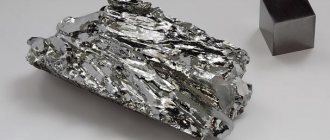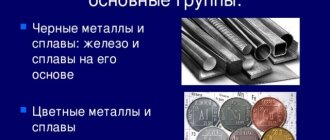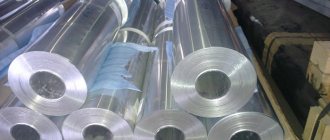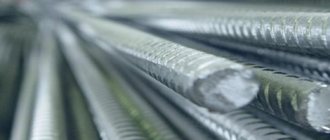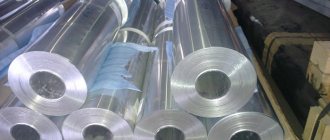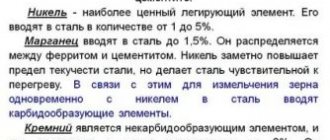Composition, structure and properties of nickel aluminides
According to the phase diagram, five compounds are formed in the alloys of the Al-Ni system: Al3Ni, Al3Ni2, AlNi (β′), AlNi3 (α′), Al3Ni5.
The Al3Ni compound has a constant composition, the remaining compounds have significant areas of homogeneity. The AlNi compound melts congruently, Al3Ni2, AlNi, AlNi3 - according to peritectic reactions. The Al3Ni5 compound is formed at a temperature of 700 °C and has a homogeneity region of 32...36% (at.) Al (Fig. 1). On the Al side, a eutectic transformation takes place in the system, the temperature of which, according to various authors, ranges from 630...640 °C, and the concentration of the eutectic point ranges from 2.5...3.06% (at.). The temperature of the peritectic transformation at which the Al3Ni compound is formed is determined to be 854 °C, and the concentration of the liquid phase involved in this transformation is 15.1 and 15.3% (at.) Ni. The Al2Ni3 compound is formed at a temperature of 1133 °C. According to other sources, the temperature of the peritectic reaction of the formation of the Al3Ni2 phase is 1132 °C, and the Al3Ni phase is 842 °C.
In this system, eutectic equilibrium is observed on the nickel side. The solubility of aluminum in nickel decreases from 11% at the eutectic temperature (1385 °C) to 6% Al at a temperature of 750 °C. In equilibrium with the nickel-based γ-solid solution is the γ′-phase, which is a solution based on the Ni3Al intermetallic compound with an fcc lattice.
On the Ni side, the invariant transformation at 1385 °C is eutectic, and at a temperature of 1395 °C it is peritectic. During the last transformation, the AlNi3 compound is formed.
Of the nickel aluminides, intermetallic compounds Ni3Al and NiAl are of greatest interest as heat-resistant materials (Fig. 1), having relatively low density and having fairly high heat resistance and heat resistance characteristics.
Rice. 1. State diagram of the Al-Ni system
Table 1. Crystal structure of compounds of the Al-Ni system
| Compound | Prototype | Pearson symbol, sp. gr. | Lattice parameters, nm | Note | ||
| a | b | c | ||||
| Al3Ni | Al3Ni | oP16, Pnma | 0,6611 | 0,7366 | 0,4812 | – |
| Al3Ni2 | Al3Ni2 | hpS, P3 m1 | 0,4036 | – | 0,4900 | At a concentration of 40 at. %Ni |
| AlNi | CsCl | cP2, Pm3 m | 0,2887 | – | – | At a concentration of 49.8 at. %Ni |
| Al3Ni5 | Ga3Pt5 | – mmmm | – | – | – | At a concentration of 32...36 at. %Ni |
| AlNi3 | AuCu3 | cP4, Pm3 m | 0,3589 | – | – | At a concentration of 75 at. %Ni |
The NiAl3 compound has an orthorhombic unit cell, which contains four nickel atoms and twelve aluminum atoms, and the Ni2Al3 compound crystallizes in the trigonal system. Aluminum atoms form a pseudocubic structure, nickel atoms occupy 2/3 of the centers of the pseudocubes, the rest remain vacant. Vacant places lie in planes perpendicular to the trigonal axis. The homogeneity region of the NiAl3 compound is very narrow, and the Ni2Al3 compound is within 4 at. % nickel (Table 1).
Nickel aluminide Ni3Al forms the basis of the berthollide type phase – the γ′-phase. The Ni3Al phase is a superstructure with a L12 type cubic lattice. In the unit cell of such a lattice, aluminum atoms occupy the vertices of the cube, and nickel atoms occupy the centers of the faces.
At room temperature, the temporary tensile strength of cast Ni3Al aluminide of stoichiometric composition (13.3% Al) is 190...215 MPa with a yield strength of 85...92 MPa and a relative elongation of about 1%. An increase in aluminum content to 14% leads to a slight increase in the strength characteristics (σв = 270...350 MPa; σ0.2 = 100...110 MPa) and relative elongation (δ5 = 1.2...1.7%) of the cast intermetallic compound. The yield strength of the Ni3Al intermetallic compound obtained by powder metallurgy methods ranges from 100 MPa with a grain size d ~ 1000 μm to 900 MPa with d ≈ 3 μm. The relative elongation in this case is 1...2.5%.
Unlike metals and alloys based on them, the yield strength of the γ′-phase (Ni3Al) does not decrease with increasing temperature to a certain value, but increases. The anomalous temperature dependence of the strength properties (yield strength) of the Ni3Al intermetallic compound is associated with a special mechanism of dislocation movement.
Plastic deformation of the Ni3Al intermetallic compound is carried out by sliding in the plane of the octahedron of superdislocations with the Burgers vector a, which consist of two a/2 type dislocations of the same sign with an antiphase boundary between them. The sliding of the first dislocation a/2<110> leads to disorder in the arrangement of atoms of the superstructure along the plane, and the sliding of the second similar dislocation restores the ordered arrangement of atoms in the slip plane. As a result, a superdislocation consisting of two dislocations moving in a completely ordered solid solution along planes should not experience any sliding resistance (to a first approximation) from the solid solution. Therefore, the coplanar motion of superdislocations occurs at low stresses.
The situation is complicated by the fact that when superdislocation a splits into two dislocations a/2, one of them leaves the octahedral slip plane and goes into the cube plane. The dislocation remaining in the slip plane must again form an antiphase boundary in order to slide, which requires an increase in stress. A section of a superdislocation that has reached a new slip plane and a dislocation that remains on the previous slip plane form a hindered complex. With increasing temperature, due to thermal fluctuations, the probability of transition of superdislocation areas to a new plane increases, and therefore the number of inhibited complexes and, as a consequence, the resistance to deformation increases. At temperatures above 600 °C, the yield strength begins to decrease due to the gradual transition from slip systems and the removal of dislocation blocking.
The ductility and strength of the Ni3Al intermetallic compound can be increased by grain refinement and increasing the purity of the starting materials. However, the most effective way to increase the complex of its properties is through alloying.
The intermetallic NiAl belongs to the daltonides with an ordered cubic body-centered crystal lattice of type B2 with a period a = 0.2887 nm with a stoichiometric composition. The theoretical density is 6.02 g/cm3, the melting point of NiAl is 1638 °C, which is higher than the melting point of nickel, cobalt, intermetallic compounds Ni3Al, Ti3Al. This makes it very promising for creating heat-resistant alloys.
Nickel monoaluminide at room temperature has brittleness, which is more pronounced in it than in Ni3Al. The fragility of NiAl aluminide is its natural property; even the most thorough cleaning cannot transform it into a plastic state. The ordered structure of the NiAl compound does not have a sufficient number of independent superdislocation slip systems to ensure plastic deformation of the polycrystalline material.
Due to its high fragility, it is difficult to estimate the true values of the strength characteristics of the NiAl intermetallic compound. In tensile tests at room temperature, the tensile strength of cast nickel aluminide of stoichiometric composition (31.5% Al) ranges from 20 to 110 MPa at zero elongation. An intermetallic compound of non-stoichiometric composition (25...28% Al) has higher strength characteristics (σв = 140...220 MPa), but also at zero elongation. The flexural strength at room temperature is about 980 MPa.
Nevertheless, with strict adherence to the chemical composition, high purity of the starting materials and optimal conditions for obtaining the intermetallic compound, it is possible to achieve a relative elongation of 2% at room temperature. Plasticity can also be increased by rapid solidification, which ensures the formation of a nanometric structure.
Influence of alloying elements on the properties of nickel aluminides
One of the objectives of alloying Ni3Al aluminide is to increase its low-temperature plasticity and reduce the tendency to intergranular fracture. This goal is achieved by doping Ni3Al with such elements as B, Zr, Hf, Cr, Mn, Fe, Co, Si. The plasticity of nickel aluminide increases as a result of a decrease in the activation energy of thermally activated dislocation processes during alloying and an increase in the number of active slip systems.
The low-temperature plasticity of Ni3Al is most effectively increased by small additions of boron, which, segregating at grain boundaries, eliminates intergranular destruction. The intermetallic Ni3Al without the addition of boron has a relative elongation of about 1%, and the relative elongation of nickel alloys with 23 and 24 at.% aluminum and 0.1% boron at room temperature reaches 35...50%. An alloy with 0.1% (at.) B can be cold rolled with a degree of deformation of 90% without intermediate annealing. The effectiveness of the influence of boron on ductility depends on the Ni/Al ratio in the alloy: with the introduction of 0.1% (at.) B into an alloy with 24% Al, the relative elongation increases to ~ 35%, and the same addition of boron into an alloy with 26% Al does not change the ductility of the alloy.
Boron also has a beneficial effect on the ductility of complex alloys. At the same time, alloys based on Ni3Al are characterized by a failure in ductility at temperatures of 600...850 °C, which is associated with the penetration of oxygen along the grain boundaries, which promotes intergranular destruction. This undesirable effect can be reduced by creating a fine-grained structure and alloying with certain elements that clear oxygen from the grain boundaries.
In increasing intensity of hardening, alloying elements can be arranged in the following sequence: Cr, V, Ti, Mo, W, Nb, Ta, Zr, Hf. Consequently, the elements strengthen Ni3Al the more, the further from nickel (to the left and below) they are located in the periodic table of D.I. Mendeleev. The increase in the strength characteristics of alloys when alloyed with these elements is due to solution strengthening. This hardening persists up to temperatures of approximately 800 °C. At a temperature of 780 °C, the tensile strength of the best Ni3Al-based alloys is 2.5 times higher than that of the Hastelloy-X alloy. At the same time, at temperatures of 850...1000 °C, all the studied alloying elements reduce the strength characteristics of the Ni3Al intermetallic compound.
Of interest are alloys based on Ni3Al alloyed with iron, in which iron partially replaces nickel and partially aluminum. With an iron content of up to 10% (at.), the alloys retain a single-phase 112 structure, and at high iron concentrations they become two-phase (γ + γ′). Alloys containing 6...15% (at.) Fe are well processed by pressure, and it is easy to obtain sheets 0.8 mm thick from them by cold rolling. The alloys are characterized by an increased yield strength compared to Ni3Al alloyed with boron, excellent corrosion resistance, and satisfactory weldability. Additional alloying of Ni-Al-Fe-B alloys with manganese and titanium increases the yield strength while maintaining sufficiently high ductility. Small additions of titanium and manganese act as a getter, binding phosphorus into matrix-insoluble phosphides, resulting in increased ductility. The introduction of carbon causes additional hardening due to the formation of dispersed carbides.
One of the effective alloying elements in the Ni3Al intermetallic compound is chromium with simultaneous alloying with boron. It provides strong solution strengthening at temperatures up to – 800 °C and reduces the loss of ductility in the temperature range 600...800 °C. Alloying Ni3Al with chromium leads to a high density of antiphase boundaries between domains, which increases ductility during hot deformation.
In terms of specific strength and heat resistance, Ni3Al alloys are superior to heat-resistant nickel alloys at temperatures of 1000...1200 °C. The oxidation resistance of Ni3Al and its alloys is higher than that of nickel-based heat-resistant alloys and can remain quite high at temperatures up to 1200 °C. The high heat resistance of alloys based on the Ni3Al intermetallic compound is due to the formation on their surface of a thin protective film based on Al2O3, which is firmly bonded to the base material.
Domestic alloys based on Ni3Al - VKNA-1V and VKNA-4U are classified as complex alloys. In the cast state, their structure is represented by primary crystals of a γ′-solid solution based on Ni3Al, refractory eutectic (γ + γ′) and boundary precipitates of MeC-type carbides. The VKNA-1V alloy contains more than 90% of a phase based on the Ni3Al intermetallic compound, about 8.5% of a γ-phase (based on nickel) and 1.2...1.5% (by weight) of carbides. As for other alloys based on Ni3Al, the yield strength of domestic alloys increases to 700 °C and then falls; the relative elongation has a minimum at 700 °C. The long-term strength of the VKNA-1V alloy at temperatures of 1100...1300 °C when tested in air without protective coatings is higher than that of the best heat-resistant nickel alloys.
Higher strength and heat-resistant properties are ensured by the formation of a single-crystal structure during casting. Hot pressing, as well as pressing followed by annealing, lead to higher mechanical properties at room temperature, but at the same time the heat resistance is lost. When tested for long-term strength at 1100 °C, samples made of cast metal fail at σ = 50 MPa after 19 hours, single-crystal samples at σ = 100 MPa after 140 hours, and from deformed metal at σ = 40 MPa after 0.18 hours. This This is due to the fact that plastic deformation destroys the refractory eutectic network at the boundaries of the primary grains of the γ′-solid solution.
The results described above served as the basis for the conclusion that the Ni3Al intermetallic compound can be the basis for the creation of cast heat-resistant alloys with operating temperatures up to 1250 °C, characterized by reduced density and high thermal stability.
In the work, when studying the physical and mechanical properties of alloys based on nickel aluminide (Ni3Al), some regularities were established between the composition, structure and properties:
- The highest resistance to oxidation at temperatures of 1200...1250 °C is possessed by the intermetallic compound Ni3Al, in which some of the nickel and aluminum atoms are replaced by chromium, titanium, molybdenum and tungsten. A composition has been developed in the Ni-Al-Cr-TiMo-W alloy system, which in the cast state is characterized by high heat resistance (the weight gain during oxidation in air for 100 hours at a temperature of 1250 °C does not exceed 24...25 g/m2);
- Alloys based on nickel aluminide of the above system, the phase composition of which is located at the interface between the γ′ and γ-phases, are distinguished by optimal heat resistance in the temperature range 900...1200 °C;
- small additions of cobalt (4...5%) to the optimal composition significantly increase fluidity when casting in a vacuum and reduce the tendency of the alloy to form hot cracks.
Kolachev’s studies note that the γ′ phase is quite plastic, therefore, with an increase in its amount in the alloys, catastrophic embrittlement does not occur, although the plasticity of nickel decreases. Tantalum, niobium and titanium effectively strengthen the γ′-phase at room temperature, and tungsten and molybdenum not only at room temperature, but also at elevated temperatures. The dissolution of cobalt in the γ′ phase does not cause its strengthening.
Due to the high solubility of alloying elements in NiAl, solution strengthening is one of the promising ways to improve its mechanical properties. Solution strengthening of NiAl aluminide is determined by the chemical interaction between the elements of the solid solution. Strengthening is caused by doping it with electrically active elements that increase the ionic component of the bond. The introduction of neutral atoms does not significantly affect the properties of the NiAl compound. The noted pattern is apparently due to the fact that the interatomic bond in NiAl is of a mixed nature with the participation of ionic, covalent and metallic components, and the share of ionic bond is very significant.
Microalloying of NiAl with additives Y, Ga, Cr, Mo, Cu, alloying with large amounts of Fe or Co, and preparation of alloys from high-purity starting materials have a positive effect on ductility. The strength characteristics of NiAl are increased by Ti, Nb, Ta, Cu.
The compositions of ternary solid solutions based on nickel monoaluminide are selected based on the regions of homogeneity of the γ'-phase in Ni-Al-Me systems. The main criterion was the presence of high solubility 5 at. % of alloying element in the intermetallic compound. The studies were carried out on alloys described by the structural formula Ni50Al50-xMe. As studies have shown, the lattice period increases compared to the value for NiAl stoichiometric composition when manganese, titanium and tantalum are introduced into the alloy. Substitution of iron, copper and cobalt in an aluminum alloy leads to a decrease in the lattice period. The maximum rate of decrease in the crystal lattice period for alloys of the studied composition is observed when alloying with cobalt, the minimum - when alloying with iron.
It is also noted that the dependence of microhardness on the content of the alloying element is close to linear for the alloys under study. The maximum rate of hardening was observed when alloying with tantalum. Titanium is also close to it in terms of its strengthening effect. When cobalt is substituted for aluminum in an alloy, the microhardness increases quite quickly, but more slowly than when alloyed with tantalum and titanium. When introducing iron into the alloy, a slight increase in microhardness values was observed. Alloying with manganese at a content in the solid solution of up to 15 at. % does not affect the microhardness of the alloy. The replacement of aluminum with copper causes a decrease in the microhardness of the alloys compared to an alloy of stoichiometric composition.
Studies of alloying within a solid solution suggest that the most promising alloying elements for increasing strength characteristics are tantalum and titanium. The introduction of manganese, iron and copper can increase ductility at low temperatures and affect the temperature of the brittle-ductile transition due to a change in the ionic component of the chemical bond.
Features of the composition
Dependence of the characteristics of the mechanical properties of the iron-nickel alloy KhN77TYUR on temperature
As a result of smelting, the structure of the alloys is a solid solution of y-iron in a nickel base. As a result of such dissolution, the stability temperature of the microstructure increases by 150...2000C. At the same time, up to 5000C, the diffusion of nickel into iron occurs very slowly, and is activated only when temperatures reach 700...8000C .
The main structural component is the intermetallic compound FeNi3, in which the nickel content, depending on temperature, is 55...75%. This predetermines the temperature range in which the heat treatment of such alloys is carried out. The highest percentage of nickel in stable alloys does not exceed 60...65% . The effect of introducing nickel into the main structure of the alloy is due to the fact that iron sharply increases thermal strength.
However, the presence of iron alone does not particularly improve the performance of iron-nickel alloys, especially those that require long-term resistance at elevated temperatures. chromium, tungsten, molybdenum, manganese and, in small quantities, silicon into the structure of iron-nickel alloys .
Thus, the main methods for obtaining the required structure of iron-nickel alloys are considered to be the mechanism of dispersion hardening, followed by heat treatment. It is produced in order to slightly increase the size of the grains in the structure and relieve internal stresses that are inevitable when some iron atoms are replaced by nickel atoms in the crystal lattice.
The fact is that nickel is corrosion resistant only in water vapor or in an atmosphere of pure oxygen (up to 9000C), and when additional sulfur or hydrogen is added there, the resistance drops to 5500C and 2800C, respectively.

